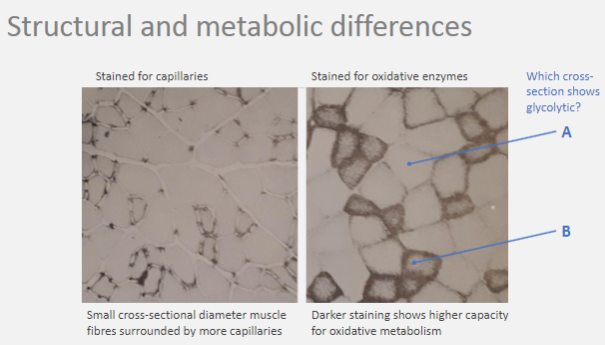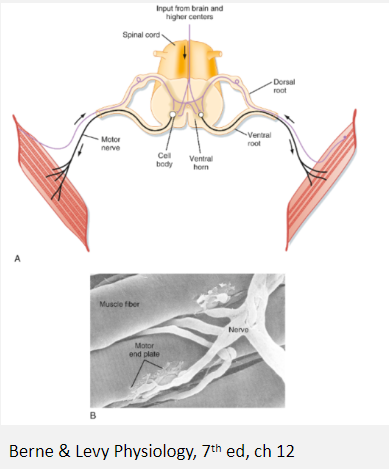How are skeletal muscle fibres classified? (1)
Skeletal muscle fibres are classified into two main groups according to contraction speed:
Slow twitch fibres (Type I)
Fast twitch fibres (Type II)
What are the characteristics of slow twitch fibres (Type I)? (5)
Fatigue resistant
Moderate maximum force
Oxidative
Many mitochondria
Rich vascularization
Small diameter
What are the characteristics of fast twitch fibres (Type II)? (6)
Fatigue rapidly
High maximum force
Glycolytic (Type IIx) or mixed (Type IIa)
Fewer mitochondria
Sparser vascularization
Larger diameter
What is the myoglobin content in slow twitch fibres (Type I)? (1)

High myoglobin ('red muscle')
What is the myoglobin content in fast twitch fibres (Type II)? (1)

Low myoglobin ('white muscle')
How does the capillary density relate to muscle fibre size and metabolic capacity? (2)

Small cross-sectional diameter muscle fibres are surrounded by more capillaries.
This indicates a higher capacity for oxidative metabolism, as shown by darker staining for oxidative enzymes.
How do myofibril proteins contribute to muscle function? (2)

Myofibril proteins exist as multiple isoforms with different functional characteristics, allowing for functional tuning in muscle fibres.
Examples include variable calcium sensitivity (troponin, tropomyosin) and the rate of ATP hydrolysis (myosin isoforms).
What myosin isoforms are expressed in slow and fast twitch fibres? (2)
Slow twitch fibres (type I) express type I myosin heavy chain (MHC).
Fast twitch fibres (type II) express type II myosin heavy chain (MHC).
How does fibre type composition vary across muscles? (3)

The lateral rectus (eye muscle) mainly consists of type II fast twitch fibres.
The gastrocnemius (calf muscle) has a mixed composition of type I and type II fibres.
The soleus (calf muscle) contains more type I slow twitch fibres.
What is the fibre type composition in long and middle distance runners? (1)
Long and middle distance runners typically have 60-70% slow twitch fibres.
What is the fibre type composition in sprinters? (1)
Sprinters typically have 80% fast twitch fibres.
What are the key characteristics of slow twitch (Type I) fibres? (5)
Slow, sustained contraction.
Fatigue-resistant.
Oxidative metabolism (lots of mitochondria and vascularization).
High myoglobin content.
Smaller diameter.
What are the key characteristics of fast twitch (Type II) fibres? (5)
Rapid, powerful contractions.
Fatigue quickly.
Glycolytic or moderate oxidative capacity.
Few mitochondria and poor vascularization.
Low myoglobin content.
How can muscle fibre type composition adapt over time? (1)
Muscle fibre type composition can adapt to the needs of the body, such as through training or specific activities.
What is temporal summation in muscle fibres? (1)

Temporal summation is the fusion of individual twitches, which generates tetanus (a state of sustained contraction resulting from rapid and repeated stimulation of a muscle fibre).
What is a motor unit and how is it involved in force generation? (3)

A motor unit consists of a motor neuron and the set of muscle fibres it innervates.
Motor unit size can range from ~10 to many hundreds of muscle fibres.
The size of the motor neuron (MN) correlates with the size of the motor unit, and muscle fibres of a motor unit are generally of the same type.
What is a motor pool and how does it contribute to muscle force generation? (2)

The motor pool is the set of all motor neurons innervating an anatomically defined muscle.
Muscle tension is increased by increasing the number of active motor units within the motor pool, which may range from tens to thousands of motor neurons.
How do fast and slow motor units differ in summation and recruitment? (2)

Fast motor units (A) require higher firing rates to generate tetanic forces than slow motor units (B, C).
Slow motor units are recruited first, followed by fast motor units to generate higher levels of force.
What is skeletal muscle tone and how is it maintained? (3)

Skeletal muscle tone refers to a low level of contractile activity that most muscles exhibit at rest.
Denervation (maybe due to injury, diseases or surgery) results in complete relaxation, leading to flaccidity.
Muscle tone is driven by reflex arcs from muscle spindles, and sectioning the dorsal roots (maybe in surgery/experimental research) abolishes resting tone.
What is the process of myogenesis? (6)

Paracrine factors induce myogenic regulatory factors (MRFs) in mesodermal precursor cells, leading to myogenic commitment (formation of myoblasts).
Myoblasts proliferate under the influence of growth factors.
Cell cycle exit and expression of myogenin (gene) marks terminal differentiation.
Structural proteins are expressed, and myotubes form from myoblasts.
Myotubes align and fuse, becoming multinucleated muscle fibres.
Satellite cells (muscle stem cells) are involved in regeneration and postnatal growth.
What is postnatal muscle growth and hypertrophy? (5)

Postnatal muscle growth involves an increase in muscle mass due to an increase in muscle fibre size (hypertrophy).
Muscle stem cells called satellite cells are undifferentiated muscle precursors that are self-renewing.
Muscle fibre growth involves satellite cell proliferation and incorporation of nuclei into muscle fibres, leading to increased protein synthesis and hypertrophy.
Muscle fibres are multinucleated, maintaining the cytoplasm:nuclei ratio.
Satellite cells return to quiescence when not needed.
What is postnatal muscle growth due to hyperplasia and how does it compare to hypertrophy? (4)
Hyperplasia refers to the formation of new muscle fibres, leading to an increase in muscle mass.
Some evidence from animal models suggests hyperplasia may contribute to muscle growth.
It is uncertain whether hyperplasia occurs in humans as a significant mechanism.
The main mechanism for muscle growth is likely hypertrophy, which involves an increase in the size of existing muscle fibres.
What is sarcopenia and how is it related to ageing? (6)

Sarcopenia is the reduction in muscle mass that occurs with ageing.
It is a normal part of the ageing process.
Atrophy (shrinkage) of muscle fibres is a major feature of sarcopenia.
Sarcopenia may also result from disease or immobilization.
It is associated with decreased satellite cell number and recruitment, which are essential for muscle regeneration.
Anabolic resistance occurs, where there is reduced protein synthesis in response to hormonal stimulation or resistance exercise.
What are the characteristics of slow twitch fibres (type I)? (3)
Slow twitch fibres generate a moderate peak force relatively slowly.
They are resistant to fatigue with repeated stimulation.
They are oxidative, meaning they rely on oxidative phosphorylation for ATP production.
What are the characteristics of fast twitch fibres (type II)? (4)
Fast twitch fibres generate a high peak force relatively quickly.
They fatigue easily.
Subdivided into:
Type IIx: Very fast contraction, mainly anaerobic, fatigue very rapidly.
Type IIa: Fast contraction, mixed aerobic/anaerobic, fatigue fairly rapidly.
What is oxidative muscle fibre metabolism? (3)
Oxidative fibres are powered by ATP generation via oxidative phosphorylation of nutrients in the mitochondria.
Type I fibres have high oxidative capacity.
Some type II fibres have moderate oxidative capacity.
What is glycolytic muscle fibre metabolism? (1)
Glycolytic fibres are powered by ATP generation via anaerobic breakdown of glucose to pyruvate through glycolysis.
This occurs mainly in type II fibres.
What is a motor pool? (2)
A motor pool consists of all the motor neurons (10s - 100s) innervating a single muscle.
The motor pool's cell bodies are located in the ventral horn of the spinal cord, with axons exiting via the ventral root to reach the target muscle.
What is a motor unit? (2)
A motor unit consists of a single motor neuron and the subset of muscle fibres (10 - 100s) it innervates within a target muscle.
A single motor neuron’s action potential generates action potentials and twitch contractions in all the fibres it innervates.
What is the size principle? (2)
The size principle refers to the orderly recruitment of motor units from a motor pool, from small to large.
Type I fibres are recruited first, followed by more type I and type II fibres as force generation increases.
What is tetanus in muscle contraction? (2)
Tetanus occurs when a motor unit fires action potentials at a high frequency, and the individual twitches fuse and summate to generate a smooth contraction.
This is an example of temporal summation.
What are myoblasts? (1)
Myoblasts are cells committed to a myogenic lineage, but not yet differentiated into muscle fibres.
What are Myogenic Regulatory Factors (MRFs)? (1)
Myogenic Regulatory Factors are transcription factors required for the commitment and terminal differentiation of muscle cells.
What are satellite cells in muscle? (2)
Satellite cells are undifferentiated muscle precursors that divide and contribute to muscle growth and regeneration.
They provide new myonuclei for muscle fibre growth and participate in muscle regeneration.
What is muscle hypertrophy? (1)
Muscle hypertrophy is the increase in muscle mass due to an increase in fibre size.
What is muscle hyperplasia? (1)
Muscle hyperplasia refers to the increase in the number of muscle fibres.
What is sarcopenia? (3)
Sarcopenia is the age-related loss of muscle mass.
It involves atrophy of muscle fibres.
It is often associated with reduced satellite cell number and reduced recruitment.